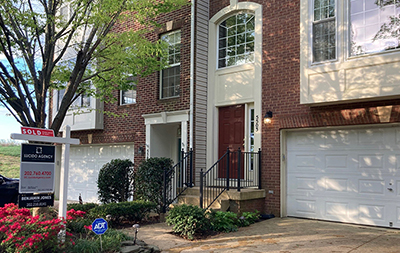
February Existing Home Sales Drop 7.2%

Existing home sales continued their yo-yo pattern, falling by 7.2 percent in February amid a stifling lack of inventory, the National Association of Realtors reported Friday.
NAR said total existing-home sales (https://www.nar.realtor/existing-home-sales) fell by 7.2% from January to a seasonally adjusted annual rate of 6.02 million in February. Year-over-year, sales fell by 2.4%. Single-family home sales fell to a seasonally adjusted annual rate of 5.35 million in February, down 7.0% from 5.75 million in January and down 2.2% from one year ago. The median existing single-family home price rose to $363,800 in February, up 15.5% from February 2021.
Existing condominium and co-op sales fell to a seasonally adjusted annual rate of 670,000 units in February, down 9.5% from 740,000 in January and down 4.3% from one year ago. The median existing condo price rose to $305,400 in February, an annual increase of 10.9%.
Every region saw monthly declines. Sales in the Northeast fell by 11.5% in February to an annual rate of 690,000, and fell by 12.7% from a year ago. The median price in the Northeast rose to $383,700, up 7.1% from one year ago. Sales in the Midwest fell by 11.3% from January to an annual rate of 1,330,000 and fell by 1.5% from a year ago. The median price in the Midwest rose to $248,900, up 7.5% from a year ago.
Sales in the South fell by 5.1% in February from January to an annual rate of 2,790,000 and increased by 3.0% from one year ago. The median price in the South rose $318,800, an 18.1% jump from one year prior. For the sixth straight month, the South experienced the highest pace of price appreciation compared to the other regions. Sales in the West slid 4.7% from January to an annual rate of 1,210,000 and fell by 8.3% from one year ago. The median price in the West rose to $512,600, up 7.1% from a year ago.
“It is tempting to blame the decline on the recent run-up in mortgage rates; however, given that last month’s sales numbers represent closings, the decline in sales came at a time earlier this year when rates were lower,” said Mike Fratantoni, Chief Economist with the Mortgage Bankers Association. “The more likely reasons for the drop in sales were the ongoing lack of housing inventory and the resulting increase in home values that priced some buyers out of the market. From a lending perspective, while the number of sales declined somewhat, with 15% home-price growth, the dollar volume of sales and purchase originations have increased over the past year.”
Fratantoni noted the only real good news in the report is the slight increase in the share of sales going to first-time homebuyers. “As we have emphasized, the strength of the 2022 housing market is dependent upon the wave of millennial homebuyers reaching peak first-time homebuyer age and finding a way into this booming housing market,” he said. “We are hopeful that the small increase in inventory and slight slowing of home price growth seen in February will continue through this spring buying season.”
Mark Vitner, Senior Economist with Wells Fargo Economics, Charlotte, N.C., also dismissed concerns over rates. “Mortgage rates have been rising since last fall, and concern about rising interest rates picked up after the FOMC signaled it would accelerate plans to normalize interest rates and begin to reverse the expansion of the Fed’s balance sheet,” he said. “Those concerns likely caused some buyers to accelerate their timetable for purchasing a home, which is a point we raised with January’s surprisingly strong rise in home sales, so sales were poised for a drop.”
Vitner said with inventories low, homes are selling unusually quickly and often have multiple bids above their asking price. “Home buyers have likely missed their opportunity to lock in an ultra-low mortgage rates,” he said. “Mortgage rates are still historically low, however…The lack of homes available for sale means buyers typically have to come in prepared to make a deal as soon as home becomes available. This favors cash buyers and buyers that have already sold a home or are pre-approved for a mortgage.”
“Housing affordability continues to be a major challenge, as buyers are getting a double whammy: rising mortgage rates and sustained price increases,” said Lawrence Yun, NAR’s chief economist. “Some who had previously qualified at a 3% mortgage rate are no longer able to buy at the 4% rate. Monthly payments have risen by 28% from one year ago – which interestingly is not a part of the consumer price index – and the market remains swift with multiple offers still being recorded on most properties.”
The report said housing inventory at the end of February totaled 870,000 units, up 2.4% from January but down 15.5% from one year ago (1.03 million). Unsold inventory sits at a 1.7-month supply at the current sales pace, up from the record-low supply in January of 1.6 months and down from 2.0 months in February.
The median existing-home price for all housing types in February rose to $357,300, up 15.0% from February 2021 ($310,600), as prices grew in each region, marking 120 consecutive months of year-over-year increases, the longest-running streak on record.
The report said properties typically remained on the market for 18 days in February, down from 19 days in January and 20 days in February 2021. Eighty-four percent of homes sold in February 2022 were on the market for less than a month.
First-time buyers represented 29% of sales in February, up from 27% in January and down from 31% in February 2021. Individual investors or second-home buyers purchased 19% of homes in February, down from 22% in January but up from 17% in February 2021. All-cash sales accounted for 25% of transactions in February, down from 27% in January and up from 22% in February 2021.
Distressed sales represented less than 1% of sales in February, equal to the percentage seen in both February and last year.
